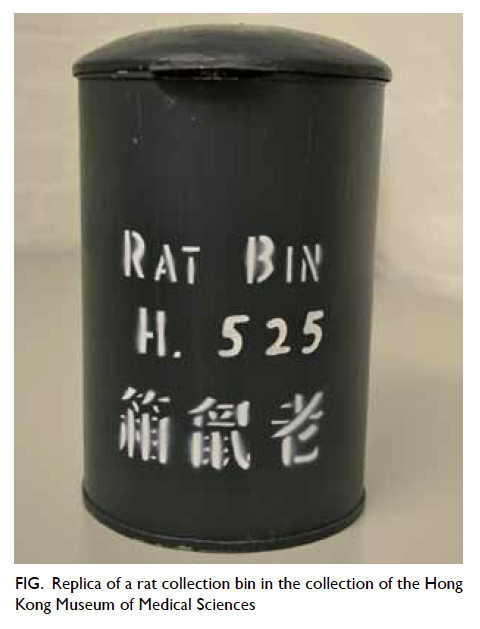© Hong Kong Academy of Medicine. CC BY-NC-ND 4.0
REMINISCENCE: ARTEFACTS FROM THE HONG KONG MUSEUM OF MEDICAL SCIENCES
The rat bin
Regina Ching, FHKAM (Community Medicine)
Member, Education and Research Committee, Hong Kong Museum of Medical Sciences Society
The Cantonese saying of “the rat bin on a lamppost”
may not be very polite when used to describe a couple.
Nonetheless rat bins on lampposts were a common
sight in Hong Kong in the last century and until 40
years ago (Fig). Exactly when the first rat bins
came into being is uncertain. What is known is that a
room for examination of rats was constructed in the
new public mortuary buildings at Hill Road in 1904.1
Rats trapped and collected from rat bins were first
screened by the naked eye and if splenic enlargement
was found, subjected to microscopic examination for
the plague bacilli. When the Bacteriological Institute
was opened in 1906, the number of rat examinations
increased steadily. According to the Medical and
Sanitary Report for the Year 1913,2 “the rat bins
were all attached to lampposts, telephone posts etc,
containing a carbolic acid disinfectant to collect
these rats. There were 650 of these bins distributed
throughout the city and suburbs, and each was visited
twice daily by rat collectors who took all rats in them
to the Government Bacteriologist.” In 1926, some
90 000 rats were examined as part of the Government’s
plague surveillance system but since then, no plague-infected
rat has been reported. In the 1950s, as
many as 944 rat bins were maintained in the streets,
collecting between 500 and 1000 rats a day.3

Figure. Replica of a rat collection bin in the collection of the Hong Kong Museum of Medical Sciences
By the mid-1970s, the fate of rat bins took an
abrupt turn when their continued existence could
no longer be justified. High operational costs,
its unsightliness as well as a poor and less-than-presentable
design, and as a potential embarrassment
to tourists who might use them as litter bins, were
some of the concerns.
With hindsight, the rat bins may have served a
number of functions; for example, reducing the risk
of spread of plague during an outbreak by disinfecting
the dead rat at the earliest opportunity and limiting
people’s exposure to it, and by detecting early disease
that could signal an outbreak. However, it is also true
that for maximal protection at the time of plague, it
was important for the public to avoid all contact with
rodents, dead or alive, rather than bringing them for
disposal in rat bins.4 Today, dead rodents should be
picked up using tongs, placed inside a tough plastic
bag, sprayed with disinfectant or diluted bleach
until soaked, double bagged, and eventually placed
in a covered rubbish bin or at the nearest refuse
collection point.5 Gloves and masks should be worn
to avoid direct contact with the rodent. All areas,
clothes, and contaminated items should be cleansed
and disinfected thoroughly afterwards.
References
1. Plague, SARS and the story of medicine in Hong Kong. Hong Kong: Hong Kong Museum of Medical Sciences Society; 2006.
2. Medical and Sanitary Reports for the year 1913. Hong Kong: Hong Kong Administrative Report; 1913: L25-6.
3. Report on pest control in Hong Kong for the year 1958-59. Hong Kong: Annual Department Report of Urban Council and Urban Services for the Financial Year 1958-59.
4. Public rat-bins. Committee Paper ENH/55/75. Hong Kong: Environmental Hygiene Select Committee.
5. Rodent pests and their control. Available from: http://www.fehd.gov.hk/english/safefood/risk-pest-rodents.html. Accessed Jun 2014.

